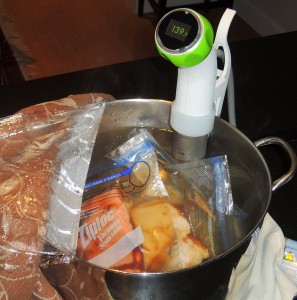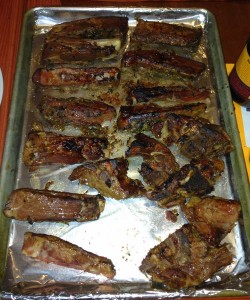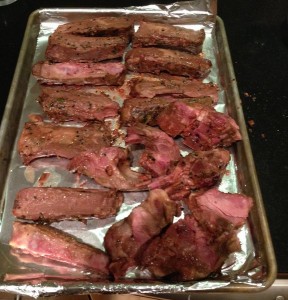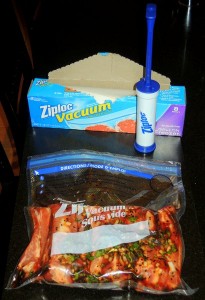1. Launch Pad on Business Radio, SiriusXM Channel 111
(7-9pm EST Wednesdays, plus replays and on-demand)
Last week I hosted on my show Lisa and Abe Fetterman from Nomiku, Dan Garblik from Bandar Foods, and Nick Taranto from Plated.com. See item 4 (below) for a test of the Nomiku appliance.
My scheduled guests for tomorrow’s show (February 12) include Talia Goldberg & Pulak Mittal (Dorm Room Fund), Scott Miller (Dragon Innovation), Ryan Cheney (Raaka Chocolate), and Laura Overdeck (Bedtime Math).
If you don’t have a SiriusXM account, you can sign-up for a free trial for an internet-only account (no credit card required).
I would love to have show suggestions. If you know a really interesting new venture with an articulate CEO, please send me email with the suggestion.
2. New Content – Teaching Modules – Two-Sided Market and Bootstrapping
When I host the radio show Launch Pad, I like to take two minutes on the air and deliver a teaching moment– a short, clear explanation of some concept related to innovation and entrepreneurship. I then re-record the audio and merge with some graphics to create a video for use in teaching. There are two here: two-sided market and bootstrapping.
Bootstrapping in Entrepreneurship – Karl T. Ulrich from Karl Ulrich on Vimeo.
Two Sided Markets from Karl Ulrich on Vimeo.
3. Wall Street Journal Experts Blog
What do you think is the biggest obstacle that millennial entrepreneurs face?
Millennial entrepreneurs, say those in their twenties, often have time and enthusiasm to devote to a new enterprise. They often lack what I call the “make-1000″ working capital to get started. For a product-based business, a key milestone is taking delivery of the first batch of product available for sale. Once you’ve got goods on the shelf, you can start selling, you can start learning, and you can start growing a business. For food products, consumer goods, and apparel, minimum order quantities tend to be from a few hundred to a few thousand units. For instance, for my bike seat company Nexride, the minimum order was 1000 saddles, which required a financial bet of $40,000. That could be two years’ rent for a millennial; pretty scary. Historically, a brave young entrepreneur went to a Visa card or Uncle Phil for that capital.
If I were thinking about this funding challenge ten years ago, I probably would have imagined a government program of some kind to provide incentives for small equity investments in young companies–bets that are a bit too risky for banks and too small for venture capitalists. Some such programs do exist, often tied to a particular city or region.
Fortunately, today, so called “crowd funding” can provide a nice alternative. Crowd funding, typically via an on-line intermediary like Kickstarter, Indiegogo, or WeFunder, offers capital without putting a credit rating, or Thanksgiving dinner with Uncle Phil, at risk. In soliciting support from the public, usually simply in the form of pre-orders, the entrepreneur tests the consumer appeal of the product while raising the make-1000 funds required to get started. Crowd funding leverages assets the millennial entrepreneur should possess abundantly: a social network, facility with the web, and an authentic story. A campaign to raise capital via crowd funding also forces the entrepreneur to make critical decisions about the target customer, the core benefit proposition, and the product design. I’m hard pressed to imagine a better mechanism for removing barriers to entrepreneurship among young people.
4. Nomiku Test
Last week (February 5) on my SiriusXM radio show Launch Pad, I interviewed Lisa and Abe Fetterman who are the co-founders of Nomiku, a maker of consumer sous vide appliances. Sous vide (“under vacuum” in French) refers to a cooking technique in which the food is vacuum sealed in a plastic bag and submerged in a water bath maintained at a precise temperature. The advantage is that you can deliver food cooked uniformly to the optimal serving temperature.

Nomiku sous vide immersion heater-circulator clipped to the side of a pot. Salmon and chicken underway. (I cover pot with plastic wrap and towels to minimize energy use.)
The interview presented a great opportunity to buy a new kitchen tool and to try it out. The Nomiku is very easy to use; just clip it to the side of a large pot filled with water, and plug it in. Then you simply turn the big green knob to set the water temperature. The unit sits there quietly and maintains the water at the precise set point.
So far I’ve cooked salmon, soft-boiled eggs, chicken, and pork ribs. Pretty fun if you’re into food and have always wanted to try sous vide.
Here are the ribs as they came out of the bag after 48 hours. Very strange. They cooked at “medium” for two days, so are still pink. So, so tender. Then, I broiled for a few minutes to brown them. These are good.

Browned for a few minutes under the broiler. Everyone was happy with these, accompanied by some white rice, reduced juice from the bag, and some baby bok choy.
Arcane foodie note: in my local Chinese grocery, pork ribs are $5-7/lb. Pork neck bones are $1/lb. The neck bones are pretty much indistinguishable in texture, fat content, and taste from the ribs. I’m going with neck bones in the future.
Incidentally, I used the inexpensive Ziploc sous vide bag system. You just zip your food in the bag and use a little hand pump to remove the air. The hand pump just pulls a vacuum on a little check valve built into the bag itself. It works quite well. I don’t feel the need for a vacuum sealing machine.

